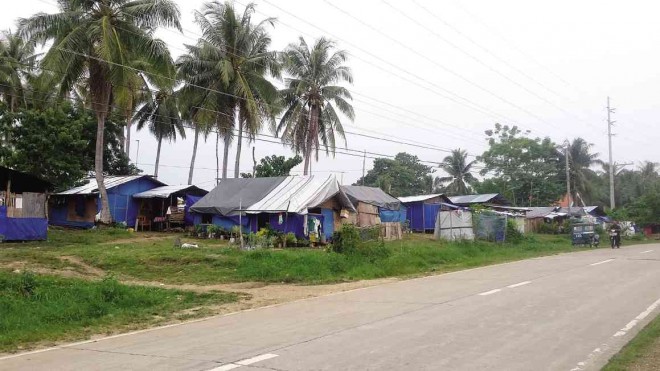After quake, Bohol folk linger in tents

AT LEAST 48 families are still staying at the “Tent City” in Barangay Basak in the town of Loon, Bohol, two years after the province was hit by a powerful quake. LEO UTDOHAN/INQUIRER VISAYAS
(Second of three parts)
TAGBILARAN CITY—While thousands of people have moved on after being displaced by the powerful earthquake that brought Bohol province to its knees two years ago, Rodelyn dela Serna and her family have encountered a string of misfortunes.
They lost their house in Loon, one of the badly hit towns, stayed in a tent as temporary dwelling for three miserable months, and rebuilt their shanty in Sitio Moalong only to be destroyed by Tropical Storm “Seniang” (international name: Jangmi) on Dec. 29, 2014.
Now, she, her husband Romeo and their nine children are cramped inside a makeshift dwelling with donated tarpaulins for a roof and plywood for walls. She and 47 other families live in similar shelters in what is now called “Tent City” in Barangay Basak.
The 7.2-magnitude quake that shook Bohol and Cebu provinces on Oct. 15, 2013, claimed the lives of at least 222 people and displaced 95,884 families (465,146 individuals). A total of 8,083 houses were destroyed and 42,771 damaged in 43 out of 47 towns and Tagbilaran City, the capital.
Article continues after this advertisement“We are like sardines inside the shelter,” Dela Serna said. “It is so hot that we feel we are being roasted.”
Article continues after this advertisementShe said the family could not build their own house because Romeo, her husband, could barely feed their children from what he earns from fishing. “We will just wait when they will fulfill their promise to move us to a house that is calamity-resistant,” she said.
The province has already purchased the lot where permanent houses will be built for the families in Tent City, said Alan Realtor, acting chief of the Loon municipal planning and development office. Construction, however, will take some time to start, he said, as the houses would be built in partnership with the private humanitarian group, Habitat for Humanity Philippines (HFHP).
Some residents have wanted to transfer because their children have been suffering from respiratory diseases, like cough and colds, while others have skin ailments.
The Department of Public Works and Highways has built a bunkhouse for the evacuees in Barangay Cogon Norte, but they have refused to stay there because it is too far from where they work.
A total of 20 bunkhouses have been put up by the department for 100 families of Barangay Napo, also in Loon, from funds provided by the Philippine Ports Authority in March 2014. Only five families are staying there.
In other areas outside Loon, quake survivors themselves have rebuilt or repaired their houses or were beneficiaries of housing projects by nongovernment organizations.
‘Disaster-resistant’
In Sagbayan town, a total of 1,035 “disaster-resistant” houses will be built under a partnership deal among the Department of Social Welfare and Development (DSWD), the provincial government and the HFHP. So far, 353 have been completed while 190 others are being put up, Mayor Ricardo Suarez said.
“You can see that our brothers and sisters here, they no longer live in tents,” Suarez said.
In Maribojoc, Mayor Leoncio Evasco Jr. proudly declared that the municipality had exceeded its target number of houses. “I think we built more than 2,000 shelters,” he told the Inquirer.
As of Sept. 30, the Provincial Shelter Program Support Unit showed that out of the 8,847 projected core houses, only 3,725 had been completed for the Re-Build Bohol Project.
Various organizations have also finished building core shelters, it said. Only the construction of those being put up by the Diocese of Tagbilaran, the DSWD, provincial government and the HFHP is ongoing.
Only 158 of the diocese’s target 2,368 core shelters have been completed. On the part of the province, HFHP and the DSWD, 2,282 core houses, or over half of the target 5,105 houses, had been completed as of Oct. 7.
“It’s 80 percent complete for core shelters. We are making sure that it will be finished as soon as possible,” said Rosalie Tima, information officer of the Bohol Information and Communication Technology Unit, which is in charge of the monitoring of data for core shelters project.
The case of schools
It is a different case in the schools.
Close to 1,000 classrooms have yet to be completed, two years after the quake. The Department of Education (DepEd) reported that only 566 classrooms out of the target of 1,590 had been put up as of Sept. 28.
Pupils, in the meantime, occupy makeshift classrooms.
For instance, at Sagbayan Central Elementary School, 450 pupils attend classes in 24 makeshift classrooms. On Oct. 15, they were expected to be transferred to 21 newly built rooms.
In Antequera town, 124 pupils of Obujan-Tagubaas Elementary School are also occupying ceiling-less classrooms after their schoolbuildings were reduced to rubble. Amakan leaves and tarps are used as roofs.
Despite the heat, the pupils and teachers have not left. “The situation of our school is not a hindrance to educate our children,” said Nimfa Ayco, a Grade 5 teacher.
Dr. Wilfreda Bongalos, DepEd supervisor for Bohol, said there was no lot available for a new school site. The Mines and Geosciences Bureau has not issued any lot clearance, she added.
But Bongalos said many pupils and students were going to better-built schools donated by foundations and nongovernment organizations. Construction of some classrooms, however, has yet to be completed, she added.
“All is well so far and we’re stabilizing,” she said.